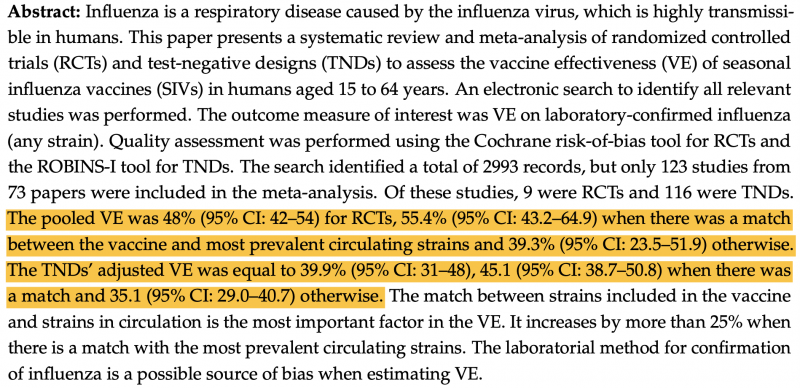impf-info.de
Nachdem Covid19 aus medizinischer Sicht "durch" ist, hier jetzt also wieder das Thema Impfen in ganzer Breite...
Influenza - Impfung bleibt schlecht wirksam, selbst wenn der Impfstoff "passt"
Eine aktuelle Studie aus Portugal mit hohem Anspruch ("systematic review and metaanalysis"... "all relevant studies") untersuchte die Wirksamkeit der Influenza-Impfung in Studien zwischen 2013 und 2023. Die Analyse beschränkte sich auf die Altersgruppe zwischen 15 und 65 Jahren und differenzierte nach Studiendesign zwischen RCTs (randomisiert kontrollierten Studien) und TNDs (Studien im so genannten Test-negativ-Design).
Die Ergebnisse sind wie erwartet desillusionierend:
- die gepoolte Impfstoff-Effektivität blieb in jedem Fall unter 50% (RCTs 48%, TNDs 39,9%) und liegt damit teilweise deutlich unter der Wirksamkeitsschwelle, die üblicherweise die Bedingung für die Zulassung eines Impfstoffs ist
- selbst wenn retrospektiv betrachtet der jeweilige Impfstoff zum jeweilig saisonalen Influenzavirus passte kamen die RCTs nur knapp über die 50% (55,4%), bei den TNDs blieb die Wirksamkeit selbst dann unter 50% (45,1%)
- und diese enttäuschenden Ergebnisse wurden in der Altersgruppe erhoben, die eigentlich ohnehin keine Zielgruppe der Impfung ist - bei den Älteren, deren Komplikationsrisiko im Erkrankungsfall höher ist, ist die Effektivität der Influenza-Impfung regelmäßig noch wesentlich schlechter (Stichwort Immunoseneszenz).

Vaccines | Free Full-Text | Seasonal Influenza Vaccine Effectiveness in Persons Aged 15–64 Years: A Systematic Review and Meta-Analysis
Influenza is a respiratory disease caused by the influenza virus, which is highly transmissible in humans. This paper presents a systematic review and meta-analysis of randomized controlled trials (RCTs) and test-negative designs (TNDs) to assess the vaccine effectiveness (VE) of seasonal influenza vaccines (SIVs) in humans aged 15 to 64 years. An electronic search to identify all relevant studies was performed. The outcome measure of interest was VE on laboratory-confirmed influenza (any strain). Quality assessment was performed using the Cochrane risk-of-bias tool for RCTs and the ROBINS-I tool for TNDs. The search identified a total of 2993 records, but only 123 studies from 73 papers were included in the meta-analysis. Of these studies, 9 were RCTs and 116 were TNDs. The pooled VE was 48% (95% CI: 42–54) for RCTs, 55.4% (95% CI: 43.2–64.9) when there was a match between the vaccine and most prevalent circulating strains and 39.3% (95% CI: 23.5–51.9) otherwise. The TNDs’ adjusted VE was equal to 39.9% (95% CI: 31–48), 45.1 (95% CI: 38.7–50.8) when there was a match and 35.1 (95% CI: 29.0–40.7) otherwise. The match between strains included in the vaccine and strains in circulation is the most important factor in the VE. It increases by more than 25% when there is a match with the most prevalent circulating strains. The laboratorial method for confirmation of influenza is a possible source of bias when estimating VE.
By accepting you will be accessing a service provided by a third-party external to https://impfinfo.de/

